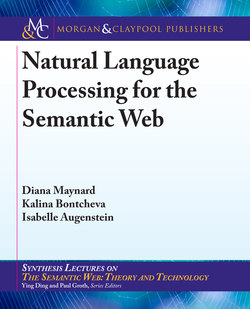Читать книгу Natural Language Processing for the Semantic Web - Diana Maynard - Страница 7
На сайте Литреса книга снята с продажи.
ОглавлениеContents
Acknowledgments
1 Introduction
1.1 Information Extraction
1.2 Ambiguity
1.3 Performance
1.4 Structure of the Book
2 Linguistic Processing
2.1 Introduction
2.2 Approaches to Linguistic Processing
2.3 NLP Pipelines
2.4 Tokenization
2.5 Sentence Splitting
2.6 POS Tagging
2.7 Morphological Analysis and Stemming
2.7.1 Stemming
2.8 Syntactic Parsing
2.9 Chunking
2.10 Summary
3 Named Entity Recognition and Classification
3.1 Introduction
3.2 Types of Named Entities
3.3 Named Entity Evaluations and Corpora
3.4 Challenges in NERC
3.5 Related Tasks
3.6 Approaches to NERC
3.6.1 Rule-based Approaches to NERC
3.6.2 Supervised Learning Methods for NERC
3.7 Tools for NERC
3.8 NERC on Social Media
3.9 Performance
3.10 Summary
4 Relation Extraction
4.1 Introduction
4.2 Relation Extraction Pipeline
4.3 Relationship between Relation Extraction and other IE Tasks
4.4 The Role of Knowledge Bases in Relation Extraction
4.5 Relation Schemas
4.6 Relation Extraction Methods
4.6.1 Bootstrapping Approaches
4.7 Rule-based Approaches
4.8 Supervised Approaches
4.9 Unsupervised Approaches
4.10 Distant Supervision Approaches
4.10.1 Universal Schemas
4.10.2 Hybrid Approaches
4.11 Performance
4.12 Summary
5 Entity Linking
5.1 Named Entity Linking and Semantic Linking
5.2 NEL Datasets
5.3 LOD-based Approaches
5.3.1 DBpedia Spotlight
5.3.2 YODIE: A LOD-based Entity Disambiguation Framework
5.3.3 Other Key LOD-based Approaches
5.4 Commercial Entity Linking Services
5.5 NEL for Social Media Content
5.6 Discussion
6 Automated Ontology Development
6.1 Introduction
6.2 Basic Principles
6.3 Term Extraction
6.3.1 Approaches Using Distributional Knowledge
6.3.2 Approaches Using Contextual Knowledge
6.4 Relation Extraction
6.4.1 Clustering Methods
6.4.2 Semantic Relations
6.4.3 Lexico-syntactic Patterns
6.4.4 Statistical Techniques
6.5 Enriching Ontologies
6.6 Ontology Development Tools
6.6.1 Text2Onto
6.6.2 SPRAT
6.6.3 FRED
6.6.4 Semi-automatic Ontology Creation
6.7 Summary
7 Sentiment Analysis
7.1 Introduction
7.2 Issues in Opinion Mining
7.3 Opinion-Mining Subtasks
7.3.1 Polarity Recognition
7.3.2 Opinion Target Detection
7.3.3 Opinion Holder Detection
7.3.4 Sentiment Aggregation
7.3.5 Further Linguistic Subcomponents
7.4 Emotion Detection
7.5 Methods for Opinion Mining
7.6 Opinion Mining and Ontologies
7.7 Opinion-Mining Tools
7.8 Summary
8 NLP for Social Media
8.1 Social Media Streams: Characteristics, Challenges, and Opportunities
8.2 Ontologies for Representing Social Media Semantics
8.3 Semantic Annotation of Social Media
8.3.1 Keyphrase Extraction
8.3.2 Ontology-based Entity Recognition in Social Media
8.3.3 Event Detection
8.3.4 Sentiment Detection and Opinion Mining
8.3.5 Cross-media Linking
8.3.6 Rumor Analysis
8.3.7 Discussion
9 Applications
9.1 Semantic Search
9.1.1 What is Semantic Search?
9.1.2 Why Semantic Full-text Search?
9.1.3 Semantic Search Queries
9.1.4 Relevance Scoring and Retrieval
9.1.5 Semantic Search Full-text Platforms
9.1.6 Ontology-based Faceted Search
9.1.7 Form-based Semantic Search Interfaces
9.1.8 Semantic Search over Social Media Streams
9.2 Semantic-Based User Modeling
9.2.1 Constructing Social Semantic User Models from Semantic Annotations
9.2.2 Discussion
9.3 Filtering and Recommendations for Social Media Streams
9.4 Browsing and Visualization of Social Media Streams
9.5 Discussion and Future Work
10 Conclusions
10.1 Summary
10.2 Future Directions
10.2.1 Cross-media Aggregation and Multilinguality
10.2.2 Integration and Background Knowledge
10.2.3 Scalability and Robustness
10.2.4 Evaluation, Shared Datasets, and Crowdsourcing
Bibliography
Authors’ Biographies
